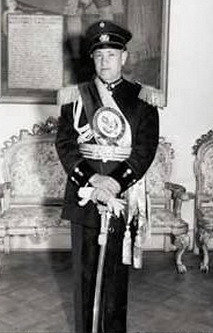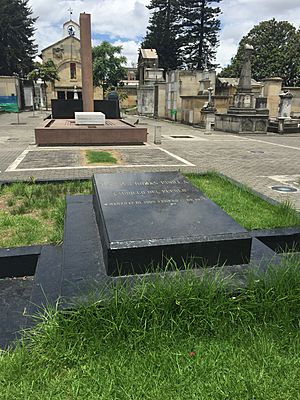Gustavo Rojas Pinilla facts for kids
Quick facts for kids
Gustavo Rojas Pinilla
|
|
|---|---|
 |
|
| 19th President of Colombia | |
| In office 13 June 1953 – 10 May 1957 |
|
| Preceded by | Laureano Gómez Castro |
| Succeeded by | Alberto Lleras Camargo |
| 25th Minister of Posts and Telegraphs of Colombia | |
| In office 3 December 1949 – 7 August 1950 |
|
| President | Mariano Ospina Pérez |
| Preceded by | José Vicente Dávila Tello |
| Succeeded by | José Tomás Angulo Lourido |
| Personal details | |
| Born | 12 March 1900 Tunja, Boyacá, Colombia |
| Died | 17 January 1975 (aged 74) Melgar, Tolima, Colombia |
| Political party | National Popular Alliance |
| Spouse | Carola Correa Londoño (1930–1975) |
| Children |
|
| Alma mater | Trine University (BCE, 1927) |
| Profession | Civil Engineer |
| Military service | |
| Allegiance | |
| Branch/service | Army |
| Years of service | 1920–1957 |
| Rank | General |
| Battles/wars |
|
Gustavo Rojas Pinilla (born March 12, 1900 – died January 17, 1975) was a very important figure in Colombia's history. He was a General in the Colombian Army. From June 1953 to May 1957, he served as the 19th President of Colombia.
He became president after a coup d'état, which means he took control of the government by force. He replaced President Laureano Gómez Castro. During his time in power, he set up a dictatorship, which is a type of government where one person has total control.
Contents
Early Life and Education
Gustavo Rojas Pinilla was born in Tunja, a city in Boyacá state, Colombia. This was on March 12, 1900. He passed away in Melgar, Tolima, on January 17, 1975.
He started his military training in 1917 at the Escuela Militar de Cadetes Gral. José María Cordoba in Bogotá. He finished his degree in 1920. In 1923, he became a lieutenant in the army while serving in Manizales, Caldas.
Rojas Pinilla later decided to study something different. In 1924, he left the army temporarily to study civil engineering in the United States. He attended Tri-State Normal College and became a civil engineer in 1927. After this, he used his engineering skills to help build roads and other important structures as part of his military work.
Military Career Highlights
In 1932, Rojas Pinilla was called back to the army. Colombia was facing a conflict with Peru, known as the Colombia-Peru War. The next year, he was put in charge of the Coast Battery at Buenaventura's port. He also worked as a military engineer there, ready for any attack from Peru.
By 1936, he was an engineer in the technical department of the Colombian Army's ammunition factory. He even went to Germany to get machines for making ammunition in Bogotá. When he returned, he became the chief of that department.
In 1943, he traveled to the United States. His mission was to buy weapons and other equipment for the Colombian military. The following year, in 1944, he became the assistant director of the School of War. In 1945, he became the director of Civil Aeronautics.
While at Civil Aeronautics, he proposed a big plan for airports in Colombia. This plan was called "Tracks of landing in Colombia." It helped him get promoted to colonel in the Army. Later, as president, he would make this plan a reality, building airports like El Dorado International Airport.
In 1946, Rojas was promoted to colonel. He was put in charge of the First Brigade in Tunja. In 1948, he became the commander of the Third Brigade in Cali. He became well-known for calming down a big rebellion in Cali. This happened after the popular leader Jorge Eliécer Gaitán was killed on April 9, 1948.
The president at the time, Mariano Ospina Pérez, honored him for his actions. On October 11, 1949, he was promoted to General. Soon after, on October 19, he was assigned to lead the Central Command of the Army.
Political Journey
On December 3, 1949, General Rojas Pinilla was given a new role. He became the Minister of Posts and Telegraphs in President Mariano Ospina Pérez's government.
In 1951, he was chosen to represent Colombia at the United Nations in Washington. He also visited the Colombia Battalion in Korea, which was fighting alongside American troops. In 1952, he was promoted to General of the Army. President Roberto Urdaneta Arbeláez then made him the Chief of Staff of the Armed Forces of Colombia.
How He Became President
On June 13, 1953, Rojas Pinilla led a peaceful coup d'état. This means he took control of the government without a lot of fighting. Both the Conservative and Liberal political parties supported this move. Their goal was to bring peace and order back to Colombia.
Rojas Pinilla ruled Colombia as a military dictator from 1953 to 1954. In 1954, he was officially named President of Colombia. The National Constituent Assembly, a special group of leaders, appointed him as president. This happened without a public election.
Key Actions as President
During his time as president, Rojas Pinilla made several important changes:
- He passed laws that gave women the right to vote, making them equal in elections.
- He introduced television to Colombia, which was a big step for communication.
- He built several hospitals and universities.
- He also supported many public works projects. These included the Atlantic railway, the hydroelectric dam of Lebrija, and the oil refinery of Barrancabermeja. These projects helped Colombia's infrastructure grow.
End of His Presidency
On May 10, 1957, many people in Colombia were unhappy with Rojas Pinilla's government. They started a huge national protest, asking him to resign. Because of this widespread protest, Rojas Pinilla was forced to leave office. This event was called a "coup d'état of public opinion."
After he left, a group of five military Generals took control of the country. This group was called a Military Junta. The Generals in this Junta were:
- General Gabriel París Gordillo
- General Rafael Navas
- General Luis E. Ordóñez
- General Deogracias Fonseca
- Admiral Rubén Piedrahita
The Junta ruled until 1958. Then, a public vote approved an older constitution from 1886. General Gabriel París Gordillo was chosen to lead the Colombian Military Junta of Government.
Freedom of the Press
During his presidency, Rojas Pinilla controlled the news and information people received. He limited the freedom of the press. He created a national radio station that mostly played government-approved content, often with Catholic messages. Thousands of radios were given out, but they could only tune into this government-controlled station called radio Sutatenza.
Right to Bear Arms
Before 1955, people in Colombia could legally own firearms. Rojas Pinilla changed this right. He created a system where people needed a special permit to own a gun. It became very hard for regular people to get these permits.
Running for President Again
After his presidency, Rojas Pinilla tried to become president again.
- In the 1962 election, he ran as a candidate for his new opposition party, ANAPO. He came in fourth place. However, his result was declared invalid because he had previously taken power through a coup.
- In the 1970 election, he ran for president again. He had a populist message, meaning he tried to appeal directly to ordinary people. He was narrowly defeated by Misael Pastrana Borrero. Rojas Pinilla and his supporters claimed that the election results were unfair and that there had been fraud.
The presidential election on April 19, 1970, was very close and caused a lot of debate. Rojas Pinilla seemed to be winning. Then, communication systems across the country stopped working. After they were fixed, the votes had been counted. The results showed a very small lead for Pastrana Borrero.
Rojas Pinilla's supporters challenged the results. They accused the government of President Carlos Lleras Restrepo of cheating. The case went to the Electoral Court. On July 15, 1970, the court decided in favor of Pastrana Borrero, confirming him as President of Colombia. This disputed election led to the creation of the 19th of April Movement, a group that later became important in Colombia.
| Political offices | ||
|---|---|---|
| Preceded by Laureano Gómez Castro |
President of Colombia 1950–1953 |
Succeeded by Military Junta |
See also
 In Spanish: Gustavo Rojas Pinilla para niños
In Spanish: Gustavo Rojas Pinilla para niños



